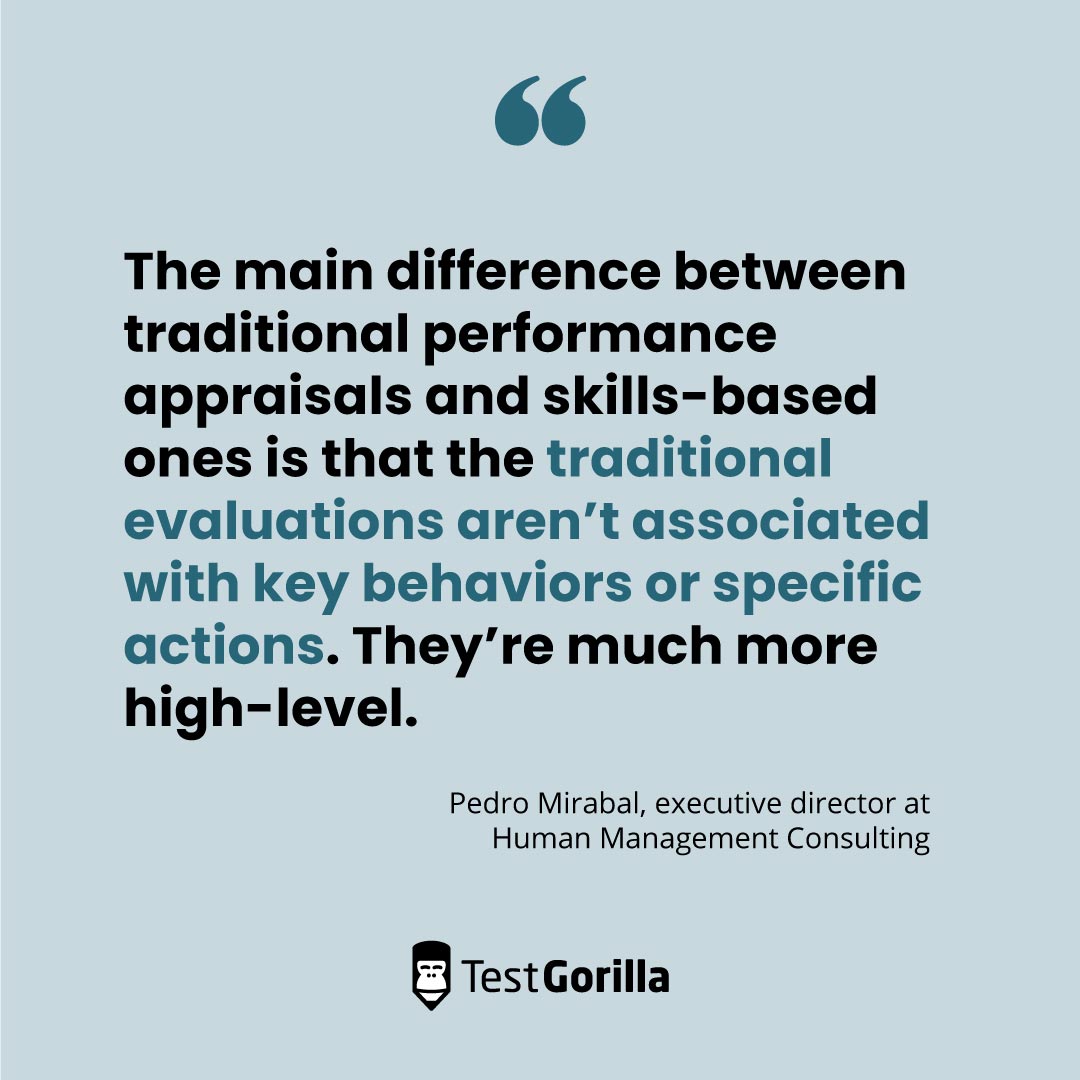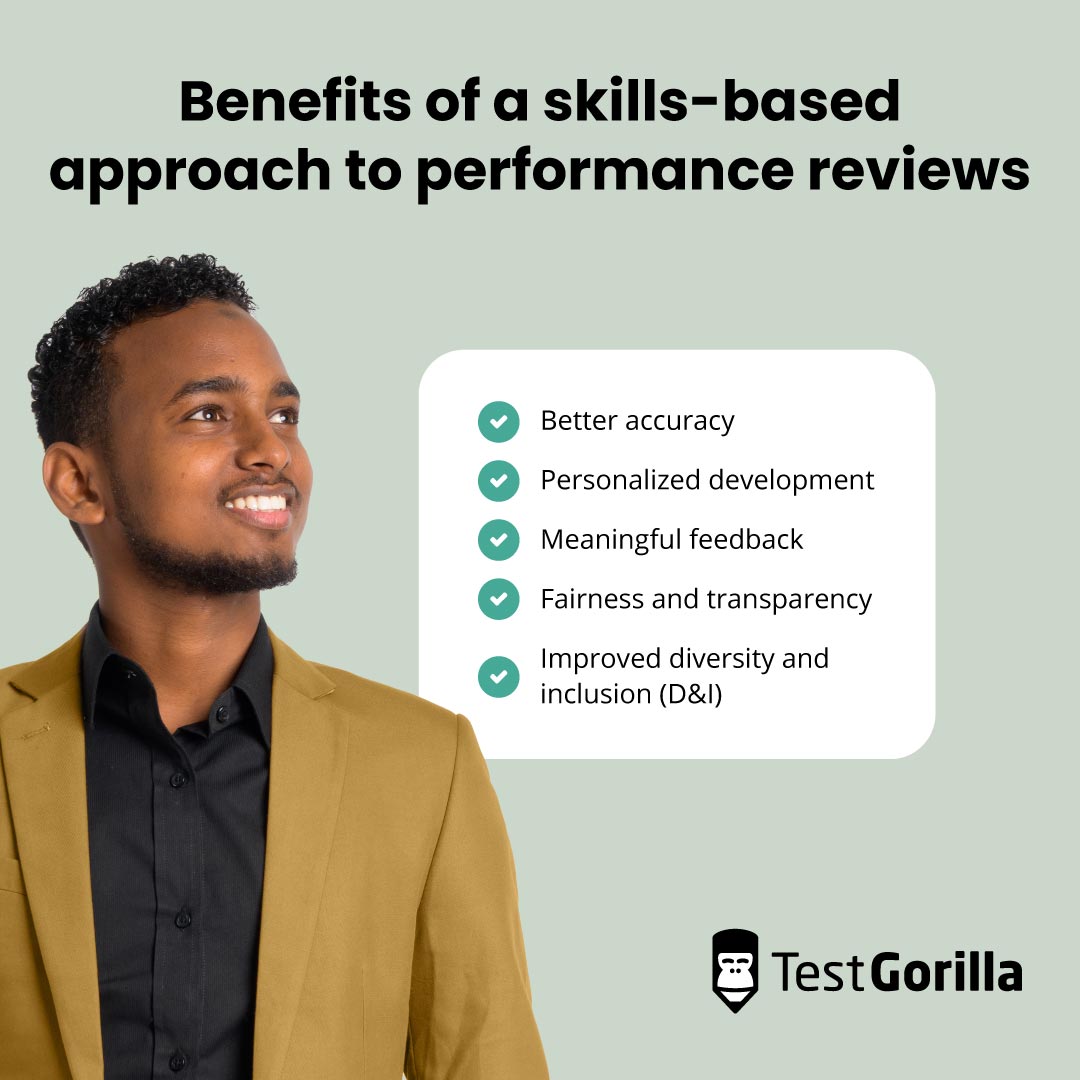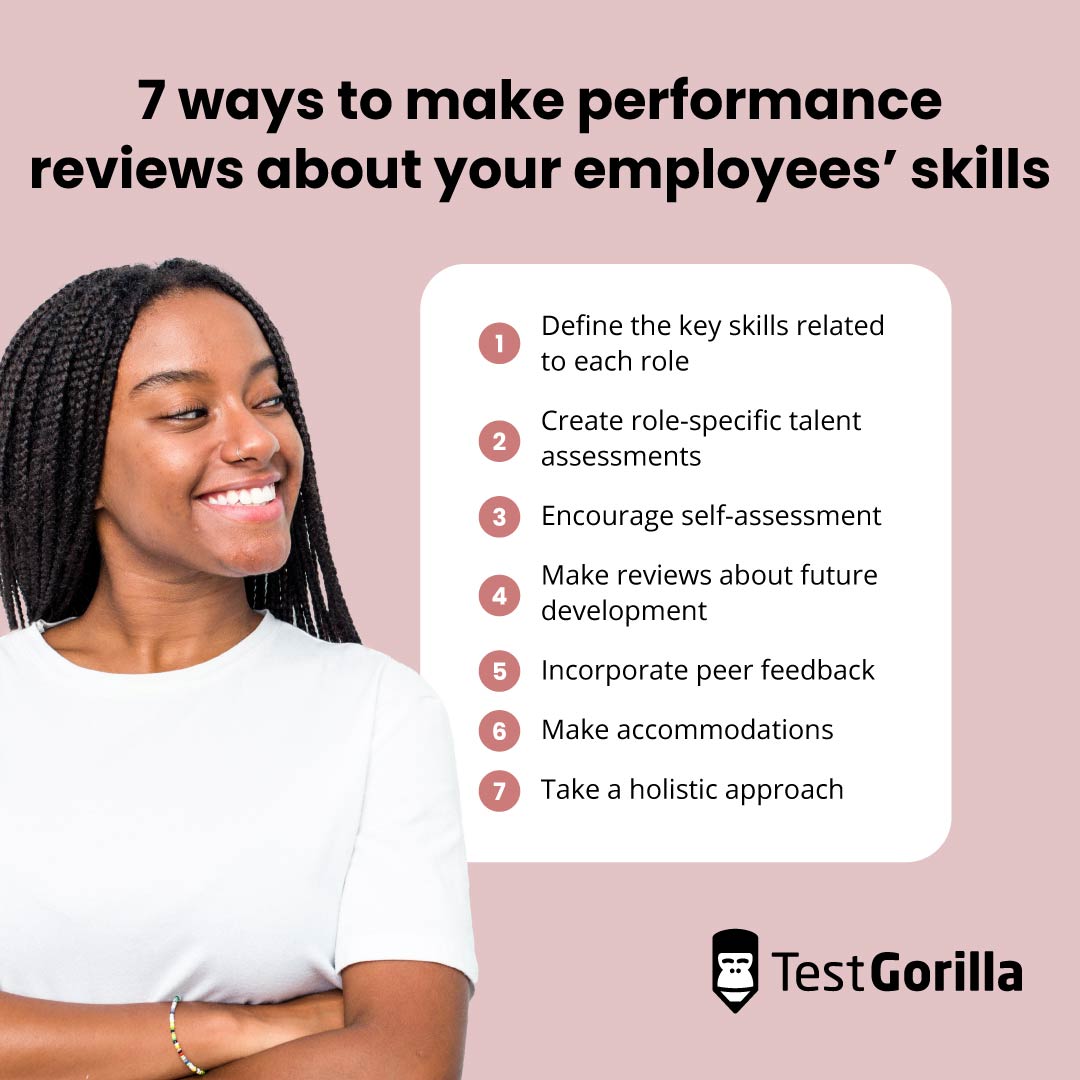It's a 10 from me: How to take a skills-based approach to performance reviews
People tend to think performance reviews are time consuming, inaccurate, and demotivating.[1] While managers can see the value behind performance reviews to reach bigger company goals and set career expectations, less than 45% believe those meetings actually achieve their purpose.[2]
This is because creating detailed processes for staff appraisals isn’t enough if you’re rating your team on a scale of one to ten. A single score lacks nuance and is highly dependent on the subjective views of the manager and the recent months prior to the meeting.
As an alternative, introducing skills-based assessments lets employees get a more balanced, realistic, and actionable evaluation of where they are in terms of knowledge and skills. This can help them decide what areas they need to focus on and create a plan for future development.
In this article, we’ll examine the problems with the most commonly used performance reviews and explain how adopting a skills-based approach can improve your company’s review season and benefit team engagement.
Quick definitions:
Traditional performance reviews: A manager and their direct report meet to talk about results. Usually, the manager reflects on previous targets and shares their perspective by going over perceived strengths and weaknesses. Then, they rate the direct report’s performance on a scale of one to ten, though the scale may differ by organization.
Skills-based performance reviews: The manager and their direct report meet to review performance indicators, skills, and expected behaviors for the role rather than personal perception. By talking about skills gaps and future development, managers can provide more objective reviews to employees. Along with skills-based hiring, this approach to performance reviews can help you improve diversity and retention – which lowers your overall hiring costs.
More than a number: The problem with performance reviews
Picture this: You meet Andy, your direct report, for her yearly performance evaluation. You only worked with her during the first three months of the year and then moved to a different project. Now, you only get to collaborate with her in team meetings.
At the beginning of the year, Andy struggled to make decisions and take initiative. You remember and write this down in her performance review sheet. However, when you left, Andy had to take the lead in a cross-departmental project, and she’s now making decisions on a daily basis. Your perception isn’t only subjective but also outdated.
The problem with traditional performance reviews is that they’re based on a single viewpoint, not objective, measurable skills. This makes them one-dimensional, vulnerable to human error, and potentially misleading.
“The main difference between traditional performance appraisals and skills-based ones is that the traditional evaluations aren’t associated with key behaviors or specific actions. They’re much more high-level,” Pedro Mirabal, executive director at Human Management Consulting, says.
For example, let’s say that Andy’s project was expected to reach $50 million in sales, and the team reported $40 million – not quite there. As Andy’s manager, you might view her performance only on a results vs targets basis, and consequently give her a low rating.
However, since traditional performance reviews lack nuance, they don’t really tell you anything about Andy’s areas of improvement or what was really behind those results.
Maybe she single-handedly made $25 million in sales, identified a gap in the team, and designed a negotiation training session that helped team members increase their sales by 3%. You wouldn’t know this just by seeing the results.
Of course, you should always make your best effort to gather feedback from others and come up with the most accurate appreciation of your direct report. However, since traditional reviews measure perceptions and hard metrics, they might be subjective and influenced by personal biases.
"A skills-based assessment, on the other hand, is closely associated with indicators and behaviors that measure a person's success in the role. These are more fair and accurate," Pedro says.
Reviewing people based on their skills reveals their strengths and weaknesses, allowing you to plan for their growth with clarity.
We’ve seen how traditional performance reviews can be biased and misleading, and can cause people to feel demotivated. Adopting a skills-based approach across your employee lifecycle, including team evaluations, might be a better solution. Let’s take a look at its benefits.
Benefits of a skills-based approach to performance reviews
A skills-based assessment is more objective and reliable because it allows you to standardize evaluation factors and measure employees against similar criteria. It’s partly for this reason that 75% of businesses are in favor of using them to evaluate their people more accurately.[3]
Having a more complete review of your people isn’t the only benefit of skills-based performance assessments – others include:
Better accuracy. Skills assessments give you more accurate insights into your employees' capabilities by eliminating subjectivity and biases. A skills-based performance review tells you where a person excels and which skills they need to continue developing.
Personalized development. Assessments give your employees insight into their strengths and areas for improvement, allowing for targeted skills development and growth. Having a clear sense of direction and growth makes people more engaged at work.[4]
Meaningful feedback. Ongoing feedback and development plans enable a more constructive dialogue between managers and employees. This helps people feel more engaged because their managers care for their development and encourage continuous improvement.
Fairness and transparency. A skills-based approach fosters unbiased and objective evaluations. This enhances trust and employee morale by giving everyone an equal opportunity to develop irrespective of any individual’s perception of them.
Improved diversity and inclusion (D&I). Evaluating people based on skills, and not on subjective perceptions, invites managers to give ratings based on specific prompts. This can help you build a diverse leadership team because promoting people based on their objective results rather than subjective or two-dimensional perceptions of their performance reduces the impact of unconscious biases.
“A skills-based assessment is supposed to be much more objective and reliable than traditional ones because you get to standardize reviews and measure everyone against similar parameters,” Pedro Mirabal, executive director at Human Management Consulting.
7 ways to make performance reviews about your employees’ skills
We’ve covered how skills-based performance reviews are fairer, keep people more engaged, and support team growth. How do you make the shift from a traditional approach?
Here are seven ways to focus your performance reviews on skills:
1. Define the key skills related to each role
“Before you start evaluating your people based on skills, you have to analyze your company and establish what your company-level, department, and role-specific skills are,” Pedro says.
You can do this by asking people to complete a survey of the skills they consider crucial to their roles. Then, you can create skills maps with levels of proficiency, seniority, and expectations per role. For example, a marketing assistant might need to have basic copywriting skills, while a marketing manager would need to be an expert in that area.
2. Create role-specific talent assessments
Standardizing skills-based reviews helps ensure fairness across your workforce. This means setting expected skills per role and department but adjusting the expected results according to level and seniority.
For example, let’s say you want to measure initiative. Below we look at Pedro's suggested approach before turning to a simpler, more immediate alternative.
“You can define it in actions, so ‘amount of times a person makes decisions or comes up with ideas in their role.’ Then, you can set targets per month based on the previous skills mapping. For instance, you can measure ‘times employee demonstrated initiative’ and set targets for low, good, and high initiative,” Pedro says.
For example, behaviors that showcase initiative could include leading a meeting, proposing to train employees on a topic, or making measured decisions.
While this could yield the insights you and your teams need, it’s a complex solution that necessitates a lot of preparation on the management side, requiring you to: Map all skills per role and level, determine which behaviors show evidence of each skill, and determine the corresponding performance indicators.
A simpler, but equally effective approach is to use a skills-based assessment platform like TestGorilla to measure your team on skills like coding with Swift, English proficiency, or marketing analytics.
With TestGorilla, you can create custom assessments for people to take before the performance review, then use the quantitative results to drive your meeting discussion.
You can also use talent assessments to evaluate people's progress by asking them to complete the assessment at the beginning of the year and then again at the end of it.
3. Encourage self-assessment
Inviting employees to assess their knowledge in certain skills allows them to self-reflect on their strengths and areas for improvement. This fosters self-awareness and helps people feel more confident in their abilities.
Self-assessments allow individuals to get a clearer picture of their performance in comparison to how their managers see their work. Having open conversations about development helps people manage expectations and understand exactly what they need to do to keep growing.
4. Make reviews about future development
Give general feedback about your direct report’s strengths and areas of opportunity throughout the year, being sure to focus on goals and next steps rather than past performance. Any feedback you do provide on specific behaviors or choices should be while issues are still fresh and haven’t lost their relevance.
Use these reviews to collaborate with employees, create individual development plans that address specific skills gaps, and set actionable goals. You can tie these plans to talent assessment results and build pathways to strengthening those skills.
“Evaluating people based on their skills helps you set career and development plans because when you can identify the gaps, you can design a learning path to close them,” Pedro says.
5. Incorporate peer feedback
You won’t always get to work alongside your direct report in all of their daily activities. Since they’re likely to have many more interactions with peers, you should ask them for feedback. Peers can give you a unique view of your direct reports’ skills and hidden talents as well as any gaps you may have missed.
Using a system to collect peer feedback helps you gain a more comprehensive view of your people’s skills. Ways to gather their insights include:
Including peer feedback surveys in your performance reviews process
Asking employees to rate their peers’ work based on skills
Implementing a yearly peer review process where workers get to assess their teammates' work based on your preferred parameters
6. Make accommodations
For your skills-based reviews to be effective, they should be adaptable to your team's preferences and make accommodations for people with specific needs.
This means designing for neurodiversity or people with disabilities, and adjusting the reviews or related materials accordingly.
For example, let’s say your review process included a mix of in-person sessions, recorded feedback, and written materials.
You should give people the chance to prepare for any tasks in advance by providing them with information on what to expect; keep instructions short and simple with clear examples; and help individuals remain focused by scheduling natural breaks in any programmed work.
7. Take a holistic approach
Rating people takes more than assigning a number on a performance review sheet. You should adopt a holistic view of evaluations and balance qualitative and quantitative evaluations. Using company values to drive that qualitative evaluation helps ensure relevance and fairness across your organization. This helps you create a more complete breakdown of each employee’s skills proficiency.
For example, you can use talent assessments as a starting point to drive the conversation and have a discussion about what your employees are doing well and where they need to improve. You can also mix skills-based assessments with an overall performance rating by doing a weighted average of each competency.
The best insights on HR and recruitment, delivered to your inbox.
Biweekly updates. No spam. Unsubscribe any time.
Evaluate people fairly and set them up for success with skills-based performance reviews
Most people understand the value behind performance reviews for personal development and reaching company goals, but they don’t think theirs are serving that purpose.[2]
Traditional performance reviews are highly influenced by managers’ perceptions and can ignore people’s abilities. This can leave employees feeling unappreciated and disconnected from their managers.
A way to solve this problem is by having performance reviews that focus on skills. Skills assessments are more accurate, fair, and personalized, as they set a standardized way of evaluating performance based on relevant data. In turn, this allows for a richer, goals-oriented discussion based on the test results.
Meanwhile, standardizing your review processes also allows you to make accommodations for neurodiversity and disabilities.
Switching from traditional to skills-based performance management doesn’t need to be complicated. You can start by mapping your organization’s skills, creating evaluations per role and type of abilities, encouraging self-assessments, and gathering employee feedback.
Using a skills-based assessment tool like TestGorilla can help you implement this approach in your business, create custom tests, and simplify data retrieval. Additionally, using performance review results to make staffing decisions can help you improve D&I across all levels of your organization.
Evaluate people based on their skills and set them up for success Create custom skills-based assessments with TestGorilla and use the results to drive conversations around performance. |
Sources:
1. “Performance through people: Transforming human capital into competitive advantage” (2023). Retrieved on August 11th, 2023. https://www.mckinsey.com/~/media/mckinsey/mckinsey%20global%20institute/our%20research/performance%20through%20people%20transforming%20human%20capital%20into%20competitive%20advantage/mgi-performance-through-people-full-report-vf.pdf
2. “2022 Performance Reset Survey – Executive summary” (2023). Retrieved on August 7th, 2023. https://www.wtwco.com/en-us/insights/2023/01/2022-performance-reset-survey-executive-summary
3. “The skills-based org in practice: Performance management” (2022). Retrieved on August 8th, 2023. https://action.deloitte.com/insight/2768/the-skills-based-org-in-practice:-performance-management
4. “State of the Global Workplace: 2023 Report” (2023). Retrieved on August 7th, 2023. https://www.gallup.com/workplace/349484/state-of-the-global-workplace.aspx
Related posts
You've scrolled this far
Why not try TestGorilla for free, and see what happens when you put skills first.

















